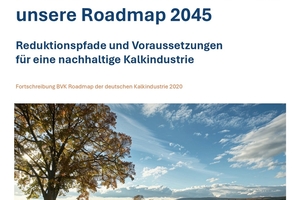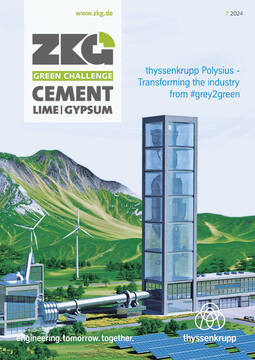German Lime Association: New CO2 roadmap presented
The lime industry aims to reduce its CO2 emissions by 133% by 2045 compared to 2022
“The future needs lime, lime needs the future,” summarizes Alexia Spieler, Chairwoman of the German Lime Association (BVK). “Over 1200 applications make lime an indispensable raw material for many industrial application processes, building materials, environmental protection and agriculture and forestry.”
However, as an energy-intensive industry with unavoidable raw material-related CO₂ emissions, the German lime industry is facing particular challenges on its transformation path. It is now setting a decisive milestone on the path to carbon-neutral production: with the publication of the new roadmap for CO₂ avoidance, the German Lime Association is presenting comprehensive strategies that outline the industry’s transformation path with interim targets up to 2030 and 2045.
The roadmap is based on information from German lime manufacturers and BVK’s own scientific surveys and is embedded in the overall strategy of the European lime industry.
The goal is clear: The lime industry wants to convert its production in such a way that lime products can be produced across all plants without CO2 emissions, i.e. climate-neutrally, by 2045 at the latest. The ability to reabsorb CO2 from the air will make the industry climate-positive.
The focus is on three technology paths: direct CO₂ avoidance, CO₂ capture and storage and carbonation. These measures are essential in order to achieve the climate targets that have been set and are being ambitiously pursued by the lime industry.
However, the lime industry can only successfully implement this transformation with the support of politicians and in agreement with civil society.
The roadmap: Three paths to the CO2 sink
The lime industry’s new roadmap focuses on three central technology paths to minimize unavoidable CO₂ emissions:
1. Direct CO₂ avoidance: By optimizing furnace technology, electrifying individual, smaller furnaces and switching fuels, almost 1/3 of CO₂ emissions can already be avoided directly. This applies in particular to the reduction of energy consumption and the use of innovative production processes and biogenic fuels, which reduce CO₂ emissions.
2. CO₂ capture and utilization (CCS, CCU, BECCS): Despite all efforts, a significant proportion of raw material-related CO₂ emissions remain unavoidable. The capture of CO₂ (carbon capture) and its subsequent use (CCU) or storage (CCS) are therefore central components of the roadmap. In addition, the use of biomass in combination with CCS (BECCS) opens up the possibility of achieving negative emissions and thus making a positive contribution to climate protection.
3. Carbonation: Carbonation, i.e. the natural CO₂ reabsorption of lime products in their life cycle, and technically enhanced CO₂ reabsorption already offer the lime industry the potential to reduce CO₂ emissions. CDR (Carbon Dioxide Removal: direct removal of CO₂ from the atmosphere) with lime products from climate-neutral production offers further, huge CO₂ reduction potential beyond our industry.
Lime industry projects on the transformation path
Companies in the German lime industry have already launched several projects that implement these three technology paths. For example, plants for CO₂ separation and new lime kilns with oxygen combustion are being built, as in the EVEREST project of Lhoist Germany, the first applications of carbonation are being tested and processes for direct CO₂ avoidance are being optimized. The use of biogenic fuels has also already begun.
These initiatives show that the lime industry has set out to transform its production towards climate neutrality - provided that the necessary political and economic framework conditions are created.
Five key political prerequisites for a sustainable lime industry
In order to successfully shape the transformation of the lime industry, not only technological innovations are required, but also a clear political framework. The BVK is therefore calling on politicians to create the following five key prerequisites:
1. Secure energy supply: The availability of renewable electricity and the development of the necessary capacities and grids are crucial for the industry in Germany. Replacing conventional fuels with sustainable biomass, climate-neutral hydrogen or other CO₂-neutral fuels is essential for climate-neutral lime production.
2. Establish a CO₂ infrastructure: For the implementation of CCS and CCU, the establishment of an efficient CO₂ infrastructure with competition-neutral access for all lime producers is essential. This includes both the transport routes and the storage facilities for CO₂, which must be implemented as quickly as possible. This also includes the creation of CO₂ storage facilities in Germany, both onshore and offshore. These are essential for economic and supply security reasons
3. Establish compliance: The legal requirements for the use of CCS and CCU nationally and internationally must be created swiftly.
4. Create economic framework conditions: Investments in research and implementation as well as funding programs for the production of climate-neutral lime are essential. It is also of great importance to ensure internationally competitive energy costs for the industry in the long term. In order to reduce the need for subsidies for low-emission basic materials such as climate-neutral lime with CCS, basic materials industries also need green lead markets in order to sell low-carbon products in a cost-covering manner.
5. Recognition of carbonation: Carbonation must be officially recognized as an effective method of CO₂ sequestration and integrated into existing climate protection instruments and monetarily rewarded in the emissions trading system (ETS) or through other systems. This also applies to CDR processes, where lime can become a game changer.
Conclusion
The lime industry is focused on the future and wants to make its contribution to achieving the climate targets in Germany. Our three technology paths are transforming the lime industry from an emitter to a CO₂ sink.
It is important that the industry‘s entrepreneurial efforts are linked to the prompt creation of the necessary conditions!
Act together now, because climate protection is a common goal for industry, politics and civil society!
For more information:








